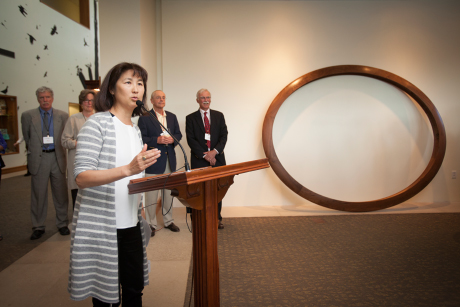Maya Lin's 'Sound Ring' unveiled at Lab of Ornithology
By Pat Leonard

Be sure to swivel your eyes to the right as you enter the Cornell Lab of Ornithology visitor center from the main entrance. You’ll see a large oval made of American walnut reclining against the wall. But there’s more to this simple sculpture than meets the eye.
The “Sound Ring” is a unique speaker system and the latest work from renowned artist Maya Lin. The “Sound Ring” is part of Lin’s “What Is Missing?” memorial to extinct, endangered or threatened species and habitats. Lin designed the work as a gift to the lab for its conservation efforts around the world.
“Viewers are drawn closer by the intriguing echoes of a huge singing ring,” said John Fitzpatrick, director of the Lab of Ornithology. “Woodcocks twitter as they fly from east to west, common nighthawks ‘peent’ from overhead, and olive-sided flycatchers ring out ‘quick, three-beers!’ from distant limbs off to the south. Haunting wails of a lonely loon carry us to a moonlit Adirondack lake. Then, hearing a chorus of clarinet-like notes overhead, we are standing beneath a family group of Indri lemurs in a Madagascar rainforest. The sounds surround us with stories of beauty, fragility, vulnerability and loss. They cry to us for help, lest they disappear forever.”
“To me, memorials represent a stepping-off point,” said Lin at the May 30 unveiling. “We can’t do anything about what has already been lost, but can we learn enough from the past to rethink a different and better future?”
The “Sound Ring” joins Lin’s other sculptures and videos that are part of the “What Is Missing?” memorial, including her “Empty Room” installation at the Herbert F. Johnson Museum of Art. The “What Is Missing?” website engages individuals to help build a global memorial to the planet – asking people to contribute stories of loss and of recovery.
“As an artist, I want to get people to think outside the box and give them hope that there is something they can do as individuals,” said Lin. “The loss of species and habitats is all about land use and resource consumption. We have to make species protection through habitat conservation a huge priority because what we’re doing right now is spending our kids’ and our grandkids’ future.”
The lab’s Macaulay Library archive provided recordings used in the “Sound Ring” to reproduce habitat soundscapes, including the North American forest, the Indian Ocean and an Amazon rainforest. Additional sounds will be added over time.
Pat Leonard is a staff writer for the Cornell Lab of Ornithology.
Media Contact
Get Cornell news delivered right to your inbox.
Subscribe